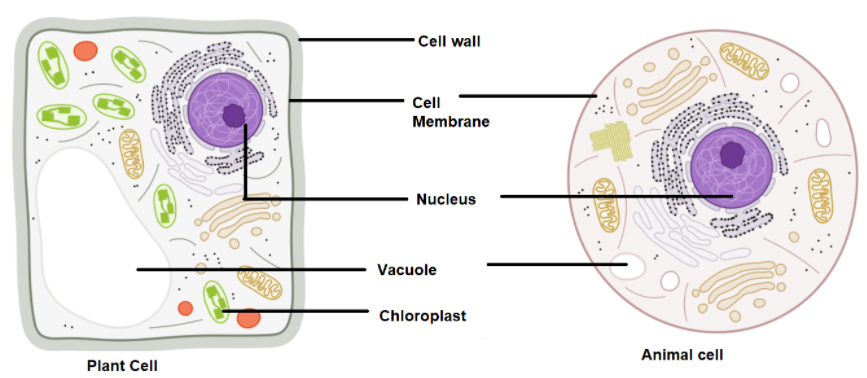
Name any one feature of this plant cell in the given diagram which is not present in an animal cell.

Guidelines 1 to 5 indicate the following
Cell wall, 2. Strong sugar solution, 3. Protoplasm, 4. Large vacuole, 5. Nucleus

Answer
496.2k+ views
Hint: The diagram given in the question represents a plant cell that is plasmolysed. Plasmolysis is defined as the shrinkage of the protoplasm when it is placed in a hypertonic solution such as a sugar solution. The plant cell has an extra-rigid layer that prevents the cell from osmotic shock.
Complete answer:
Osmosis is the process of movement of water molecules from their region of higher concentration to lower through a semipermeable membrane. In the case of cells, the semipermeable membrane is the plasma membrane.
The figure given in the question represents a plasmolysed plant cell where exosmosis or outward movement of water has taken place. This happens when the cell is placed in a hypertonic solution like sugar or salt solution. The water is at a higher concentration in the protoplasm moves to the outside.
This movement of water takes place till the concentration of the solvent is equal. Hence the strong sugar solution has entered the cell which is evident from the figure given. The presence of a cell wall holds the cell membrane and keeps it in a distended position.
In the case of animal cells when placed in a hypertonic solution, the protoplasm along with the plasma membrane shrinks as there is no cell wall to hold the cell membrane. Other than the cell wall the protoplasm, vacuole( although not large) and the nucleus is common to both plant and animal cells.

From the above discussion, it is evident that animal cells do not have cell walls.
Note:
- The other important structure that is absent in animal cells is the chloroplast. They are important centres of photosynthesis.
- The animal cells possess centrioles which are absent in the plant cell.
- The hypertonic solution is the solution where the concentration of solute is greater than the solvent.
Complete answer:
Osmosis is the process of movement of water molecules from their region of higher concentration to lower through a semipermeable membrane. In the case of cells, the semipermeable membrane is the plasma membrane.
The figure given in the question represents a plasmolysed plant cell where exosmosis or outward movement of water has taken place. This happens when the cell is placed in a hypertonic solution like sugar or salt solution. The water is at a higher concentration in the protoplasm moves to the outside.
This movement of water takes place till the concentration of the solvent is equal. Hence the strong sugar solution has entered the cell which is evident from the figure given. The presence of a cell wall holds the cell membrane and keeps it in a distended position.
In the case of animal cells when placed in a hypertonic solution, the protoplasm along with the plasma membrane shrinks as there is no cell wall to hold the cell membrane. Other than the cell wall the protoplasm, vacuole( although not large) and the nucleus is common to both plant and animal cells.

From the above discussion, it is evident that animal cells do not have cell walls.
Note:
- The other important structure that is absent in animal cells is the chloroplast. They are important centres of photosynthesis.
- The animal cells possess centrioles which are absent in the plant cell.
- The hypertonic solution is the solution where the concentration of solute is greater than the solvent.
Recently Updated Pages
Why are manures considered better than fertilizers class 11 biology CBSE

Find the coordinates of the midpoint of the line segment class 11 maths CBSE

Distinguish between static friction limiting friction class 11 physics CBSE

The Chairman of the constituent Assembly was A Jawaharlal class 11 social science CBSE

The first National Commission on Labour NCL submitted class 11 social science CBSE

Number of all subshell of n + l 7 is A 4 B 5 C 6 D class 11 chemistry CBSE

Trending doubts
Differentiate between an exothermic and an endothermic class 11 chemistry CBSE

10 examples of friction in our daily life

One Metric ton is equal to kg A 10000 B 1000 C 100 class 11 physics CBSE

Difference Between Prokaryotic Cells and Eukaryotic Cells

1 Quintal is equal to a 110 kg b 10 kg c 100kg d 1000 class 11 physics CBSE

State the laws of reflection of light




